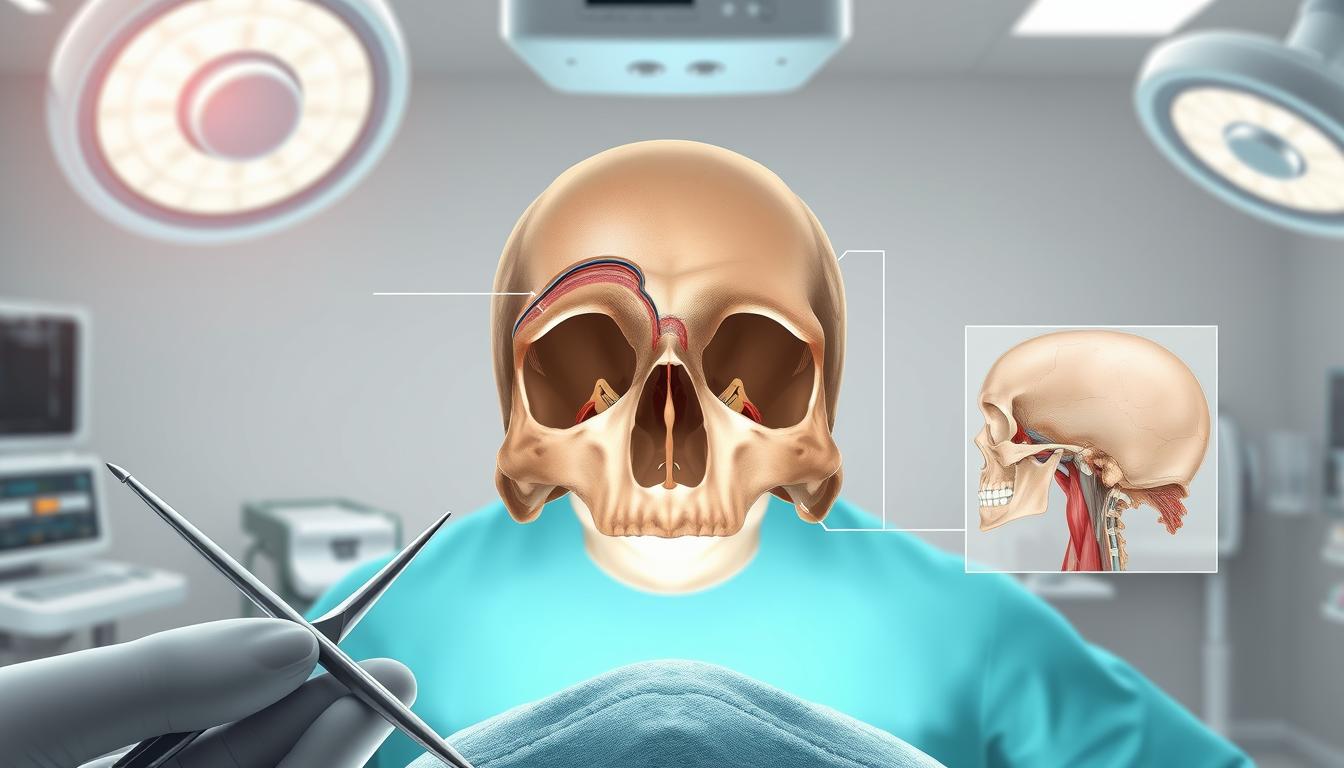Forehead reduction surgery, also known as hairline lowering surgery, is a cosmetic procedure designed to create better facial proportions by reducing the height of the forehead. This surgery involves removing a strip of skin from the upper forehead and advancing the hairline forward.
Many individuals seek forehead reduction to address concerns about a disproportionately large forehead that may cause self-consciousness or limit hairstyling options. The procedure offers immediate visible results with a recovery period that allows most patients to return to normal activities within 1-2 weeks.
Key Takeaways
- Forehead reduction surgery creates better facial proportions.
- The procedure involves removing a strip of forehead skin and advancing the hairline.
- It addresses concerns about a disproportionately large forehead.
- Immediate visible results with a relatively short recovery period.
- Enhances facial harmony and proportion through permanent alteration of the hairline position.
What is Forehead Surgery Reduction?

Individuals with a high or prominent forehead often consider forehead reduction surgery to achieve a more balanced facial appearance. Forehead reduction surgery is a cosmetic procedure that aims to reduce the height of the forehead by repositioning the hairline.
Definition and Purpose
Forehead reduction surgery is defined as a surgical intervention that decreases the size of the forehead. The primary purpose of this surgery is to create a more proportionate facial structure, enhancing the overall aesthetic appeal.
Alternative Names and Approaches
Forehead reduction surgery is known by several alternative names, including hairline lowering surgery, scalp advancement, and forehead shortening. Beyond traditional forehead reduction, there are alternative approaches such as hairline-lowering transplants that use hair grafting techniques to achieve similar results.
- Forehead reduction surgery is known by several alternative names including hairline lowering surgery, scalp advancement, and forehead shortening.
- Beyond traditional forehead reduction, there are alternative approaches such as hairline-lowering transplants that use hair grafting techniques to achieve similar results.
- Hair transplantation can be used as a standalone procedure or in combination with surgical forehead reduction to create a more natural-looking hairline.
Benefits of Hairline Lowering Procedures
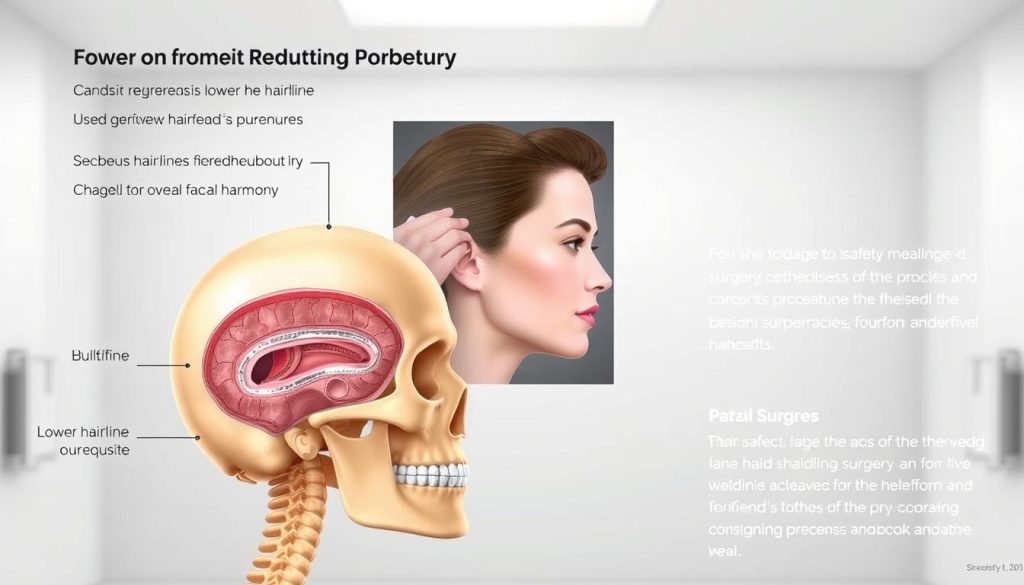
The benefits of hairline lowering procedures extend beyond aesthetic improvements to impact psychological well-being. Forehead reduction surgery can significantly alter one’s appearance, leading to a more harmonious facial balance.
Facial Harmony and Proportion
Forehead reduction surgery can greatly enhance facial aesthetics by creating a more balanced proportion between the forehead and other facial features. A lower hairline can make the face appear more symmetrical, contributing to an overall more attractive appearance. By adjusting the hairline, patients can achieve a more proportionate facial structure.
Psychological Impact and Confidence
The psychological benefits of forehead reduction can be profound. Many patients report a significant boost in self-confidence and a more positive body image following the procedure. The results of hairline lowering can lead to enhanced social confidence and reduced anxiety in interpersonal interactions. Key benefits include:
- The psychological benefits of forehead reduction can be profound, often resulting in significant improvements in self-confidence and body image.
- Many patients report feeling liberated from the constant need to hide their forehead with specific hairstyles, particularly bangs or fringes.
- The procedure allows for greater versatility in hairstyling options, enabling patients to wear their hair pulled back without self-consciousness.
- Studies show that facial aesthetic improvements often correlate with enhanced social confidence and reduced anxiety in interpersonal interactions.
- Patients frequently report feeling more comfortable in photographs and social situations after addressing concerns about their forehead proportions.
- The permanent nature of the results provides lasting psychological benefits, eliminating the daily stress of managing appearance concerns related to forehead size.
- For many patients, the boost in confidence extends beyond appearance to impact professional opportunities and personal relationships positively.
Ideal Candidates for Forehead Reduction
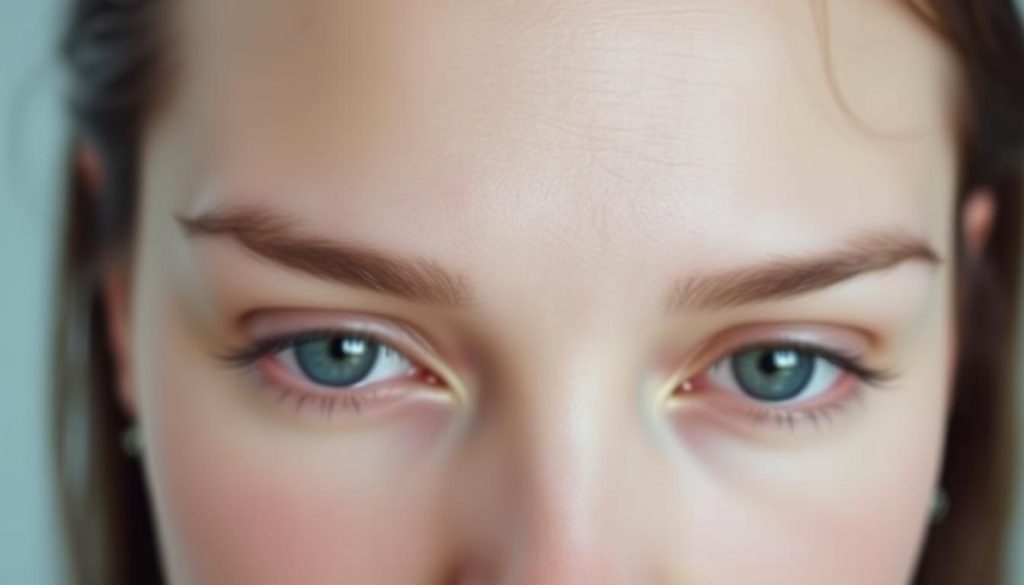
Determining if you’re an ideal candidate for forehead reduction involves evaluating several key factors. Forehead reduction surgery, a procedure aimed at reducing the height of the forehead, requires a thorough assessment of a patient’s physical characteristics, health status, and expectations.
Physical Characteristics and Scalp Laxity
The physical characteristics of a patient play a crucial role in determining their suitability for forehead reduction surgery. Scalp laxity, or the looseness of the scalp, is an important factor as it affects the surgeon’s ability to adjust the hairline effectively. Patients with a high hairline and sufficient scalp laxity are generally considered good candidates.
Health Requirements and Contraindications
Certain health requirements and contraindications can affect a patient’s eligibility for forehead reduction surgery. For instance, individuals with a history of pattern baldness or progressive hair loss are typically not ideal candidates because future hair loss could expose the surgical scar. Other contraindications include certain autoimmune disorders, smoking, unrealistic expectations, and medical conditions like uncontrolled diabetes or hypertension.
- Candidates must be in good overall health without conditions that could impair healing or increase surgical risks.
- Individuals with a history of pattern baldness or progressive hair loss are generally not good candidates.
- Patients with certain autoimmune disorders affecting the skin or scalp may not be suitable.
- Smoking cessation is mandatory before and after surgery due to its impact on healing.
- Those with unrealistic expectations should reconsider, as understanding the limitations is crucial.
- Certain medications affecting blood clotting must be discontinued under medical supervision.
- Patients with a history of keloid scarring or hypertrophic scars require careful evaluation.
- Medical conditions like uncontrolled diabetes or hypertension are contraindications until properly managed.
The Forehead Reduction Procedure Explained
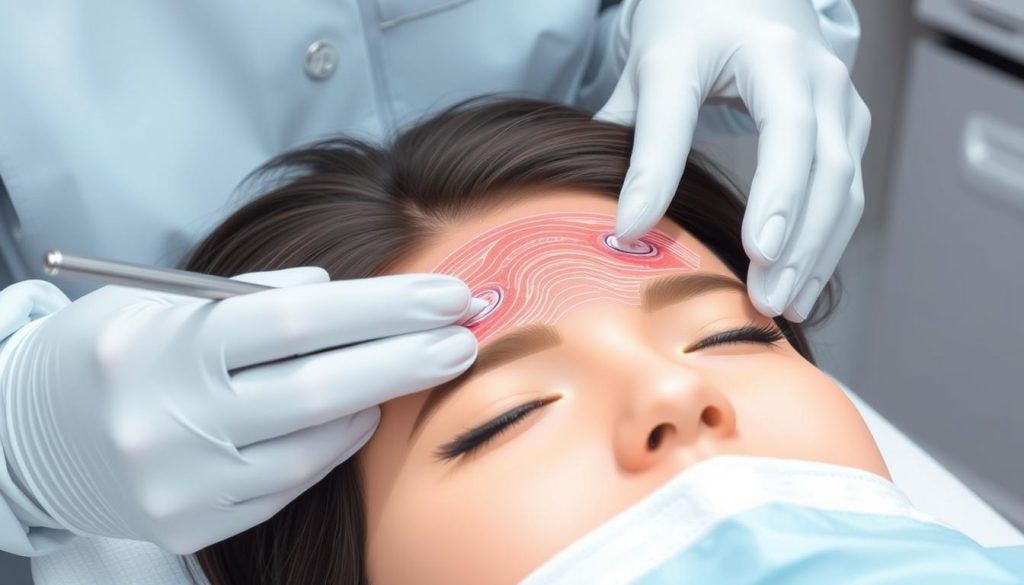
Forehead reduction surgery is a complex procedure that requires careful planning and execution. To ensure a successful outcome, a thorough understanding of the surgical process is essential.
Pre-Surgical Consultation and Planning
Before undergoing forehead reduction surgery, patients must attend a pre-surgical consultation. During this meeting, the surgeon will assess the patient’s forehead structure and discuss their goals and expectations.
Step-by-Step Surgical Process
The forehead reduction procedure involves several key steps. The surgery is typically performed under general anesthesia to ensure patient comfort. The surgeon will then make the necessary incisions and modify the forehead’s shape and size accordingly.
Anesthesia and Operating Time
Forehead reduction surgery requires general anesthesia for patient comfort. The average operating time ranges from 1.5 to 3 hours, depending on the complexity of the case. The procedure is typically performed on an outpatient basis, allowing patients to return home the same day.
Key aspects of the procedure include:
– Forehead reduction surgery is typically performed under general anesthesia.
– The anesthesiologist will conduct a thorough pre-operative assessment.
– The procedure is usually done as an outpatient surgery.
Recovery After Forehead Surgery Reduction

Understanding the recovery process after forehead reduction surgery is essential for patients to ensure a smooth and successful healing journey. The recovery period involves several stages, from immediate post-surgery care to long-term healing.
First Week Post-Surgery
The initial recovery phase after forehead reduction surgery is critical. Patients must keep their incision clean and monitor for signs of infection. Swelling and bruising are common during this period, but these symptoms typically subside within a few weeks.
- Most residual swelling resolves within 2-3 weeks.
- Patients can hide their incision by styling their hair to mask the scar.
Long-Term Healing Timeline
The complete healing process after forehead reduction continues for several months. It takes about six months for the incision to heal completely, although the final results are visible immediately.
- The incision line typically appears red or pink for the first few months before fading.
- Hair growth through and around the incision begins around 3 months post-surgery.
- Patients can resume normal activities, including vigorous exercise, by 4-6 weeks post-surgery.
Proper care during the recovery period is crucial for minimizing complications and ensuring optimal results. Regular follow-up appointments are scheduled to monitor progress and address any concerns.
Potential Risks and Complications
Understanding the potential risks and complications associated with forehead reduction surgery is crucial for informed decision-making. While the procedure is generally safe when performed by a qualified surgeon, there are several factors to consider.
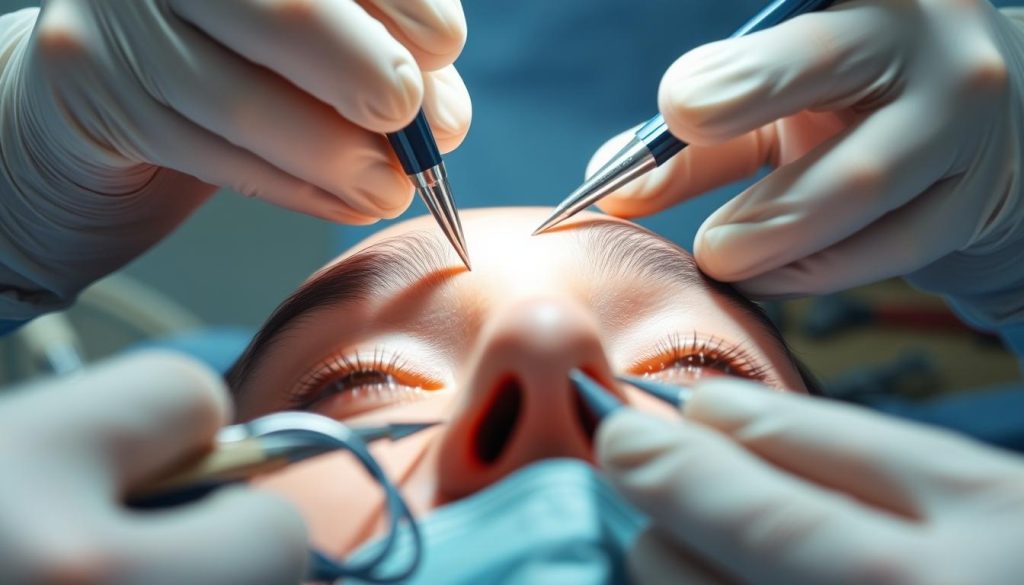
Common Side Effects and Management
Common side effects of forehead reduction surgery may include swelling, bruising, and discomfort. These can typically be managed with medication and proper post-operative care. Proper wound care is essential to prevent infection and promote healing.
- Swelling and bruising are common and usually resolve on their own.
- Discomfort can be managed with prescribed pain medication.
Serious Complications and Prevention
While rare, serious complications can occur. These include infection, widened or hypertrophic scarring, permanent hair loss along the incision line, hematoma or seroma formation, and asymmetry or suboptimal aesthetic results. Choosing a board-certified plastic surgeon with experience in forehead reduction surgery significantly reduces these risks.
- Infection can be prevented with proper wound care and prophylactic antibiotics.
- Scarring can be minimized with proper surgical technique and patient selection.
- Permanent hair loss can be addressed with hair transplantation if necessary.
By understanding these potential risks and taking steps to mitigate them, patients can have a more successful and satisfying outcome from their forehead reduction surgery.
Expected Results from Forehead Reduction

Forehead reduction surgery yields transformative results that enhance facial harmony. The procedure is designed to lower the hairline, creating a more balanced facial proportion.
Immediate vs. Long-Term Results
The results of forehead reduction surgery can be observed in both the short and long term. Immediately after the procedure, the forehead appears lower, and the hairline is redefined. As the swelling subsides and the scalp heals over the following months, the final results become more apparent, revealing a natural hairline that frames the face.
Scarring and Hair Regrowth
The surgical technique used in forehead reduction ensures that the incision is hidden within the hairline, minimizing visible scarring. Key benefits include:
- The incision is strategically placed within or just behind the hairline for optimal concealment.
- Hair regrowth through and around the incision begins approximately 3 months after surgery.
- The surgical technique preserves hair follicles along the incision line, ensuring natural hair growth patterns.
- Proper scar care improves the final appearance of the scar.
By carefully executing the procedure and following post-surgical care instructions, patients can achieve a natural-looking hairline with minimal scarring.
Combining Forehead Reduction with Other Procedures

Forehead reduction surgery can be combined with other cosmetic procedures to achieve more comprehensive facial rejuvenation. This approach allows patients to address multiple aesthetic concerns simultaneously, potentially reducing overall recovery time and enhancing the overall outcome.
Brow Lifts and Rhinoplasty
Combining forehead reduction with brow lifts and rhinoplasty can significantly enhance facial harmony. A brow lift can help reduce forehead wrinkles and elevate the eyebrows, while rhinoplasty can reshape the nose to better proportion with the rest of the facial features. This combination of procedures can lead to a more refreshed and youthful appearance.
Hair Transplants and Other Facial Surgeries
Hair transplantation can be performed alongside forehead reduction to enhance hairline density or create a more natural-looking hairline. Other facial surgeries such as facelifts, eyelid surgery, or chin augmentation can also be combined with forehead reduction for comprehensive facial rejuvenation. The timing of these combined procedures must be carefully planned to ensure optimal healing and results.
Cost Factors for Forehead Reduction Surgery

Forehead reduction surgery cost varies widely based on several factors, including location and surgeon expertise. The total amount a patient pays can be influenced by multiple elements.
Price Range and Geographic Variations
The cost of forehead reduction surgery can differ significantly based on geographic location. Major cities tend to have higher prices compared to smaller towns. It’s essential to consult with a board-certified plastic surgeon to get an accurate estimate tailored to your specific needs and goals.
Additional costs for anesthesia, facility fees, and post-operative care may also apply.
Financing Options and Considerations
Most plastic surgery practices offer financing options through medical credit companies such as CareCredit, Alphaeon Credit, or Prosper Healthcare Lending. These plans typically offer terms ranging from 6 to 60 months, sometimes with promotional interest-free periods for qualified applicants.
Patients should inquire about what is included in the quoted price and consider the overall cost and value of the procedure.
Finding a Qualified Surgeon for Your Transformation

When considering forehead reduction, finding a qualified surgeon is paramount. The right plastic surgeon will have the necessary training and experience in forehead reduction surgery or hairline lowering surgery.
- Board certification in plastic surgery or facial plastic surgery is a minimum requirement.
- Specialized training and extensive experience in forehead reduction procedures are essential.
- Reviewing before-and-after photos helps evaluate their aesthetic approach.
- Schedule consultation with multiple surgeons to compare approaches.
By choosing a qualified surgeon, patients can ensure a safe and successful forehead reduction surgery.
FAQ
What is the typical recovery time for hairline lowering procedures?
The recovery time varies, but most patients can return to their normal activities within a week to ten days after the procedure. Swelling and bruising usually subside within a few weeks.
Will I have visible scarring after the forehead reduction procedure?
The incision is typically made along the hairline, and while some scarring is unavoidable, it is usually minimal and hidden by the hair. The surgeon will take steps to minimize scarring and ensure it is as inconspicuous as possible.
Can I undergo hairline lowering surgery if I have a high hairline?
Yes, hairline lowering surgery can be an effective solution for individuals with a high hairline. The procedure can help create a more balanced and harmonious facial appearance.
How long does the forehead reduction surgery procedure take?
The length of the procedure can vary, but it typically takes around one to two hours to complete, depending on the complexity of the case and the individual’s anatomy.
What are the potential risks and complications associated with forehead reduction?
As with any surgical procedure, there are potential risks and complications, including infection, scarring, and adverse reactions to anesthesia. A qualified surgeon will discuss these risks and take steps to minimize them.
Can I combine hairline lowering with other facial surgeries, such as rhinoplasty?
Yes, it is possible to combine hairline lowering with other facial surgeries, such as rhinoplasty or brow lifts. This can help achieve a more comprehensive facial rejuvenation and enhance overall results.
How much does forehead reduction surgery cost?
The cost of forehead reduction surgery varies depending on factors such as the surgeon’s fees, location, and complexity of the procedure. It’s essential to consult with a qualified surgeon to get a personalized quote.
What kind of anesthesia is used during the procedure?
The type of anesthesia used can vary, but it is typically performed under local anesthesia with sedation or general anesthesia, depending on the individual’s needs and the surgeon’s recommendation.
